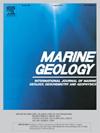Depositional control on the fate of reactive iron in shelf sediments since the last deglaciation: A case study of the East China Sea
Abstract
The East China Sea (ECS) is located between the Eurasian continent and the Pacific Ocean with a wide continental shelf, which acts as a potential source of reactive iron in the Western Pacific. However, the source and fate of reactive iron in continental shelf sediments of the ECS remain poorly constrained. Here, we examined the influence of the depositional environment on the fate of reactive iron on the continental shelf of the ECS since the last deglaciation. The contents of redox-sensitive elements (U and Mo) indicate that the sediments in the ECS inner shelf have primarily deposited in oxic and suboxic environments since 18.5 ka. The ratio of reactive iron to total iron (FeHR/FeT) ranges from 0.24 to 0.41, and the ratio of total iron to aluminum (FeT/Al) is approximately 0.55 ± 0.11. These ratios suggest that the majority of reactive iron is derived from fine-grained terrestrial sediments discharged by the Changjiang River. The contents of Fepy and Fecarb exhibit opposite trends with depth in the core, indicating competition between carbonate (bicarbonate) ions and sulfide ions for ferrous ions. This competition is primarily controlled by the depositional environment and redox state since 18.5 ka. The Fecarb is the dominant iron speciation throughout the core sediments, but its abundance declined since 13.2 ka when the ECS inner shelf was influenced by seawater transgression due to deglacial sea-level rise. The Fepy content reached its maximum when the ECS inner shelf was fully flooded. Our study highlights the depositional control on the source-sink processes of reactive iron, providing new insights into the fate of reactive iron on continental shelves in response to environmental evolution.

 求助内容:
求助内容: 应助结果提醒方式:
应助结果提醒方式:


